Journal of
eISSN: 2378-3184


Research Article Volume 7 Issue 2
Department of Ocean Studies and Marine Biology Pondicherry University India
Correspondence: CH Ramesh Andaman and Nicobar Centre for Ocean Science and Technology India
Received: February 20, 2018 | Published: March 13, 2018
Citation: Ramesh CH, Mohanraju R. Footprints and tracks of marine organisms. J Aquac Mar Biol. 2018;7(2):74 – 78. DOI: 10.15406/jamb.2018.07.00188
Footprints of marine animals have not been studied so far and much attention was not given. Stupendously, this study provides a new insight on various footprints of marine annelids, arthropods, molluscs, echinoderms, fish, reptiles, mammals and birds to monitor their biodiversity. The size and depth (horizontal and vertical measurements) of footprints are species specific and also depends on size of the individual. Foot signs of some of the terrestrial animals which move to coastal regions are also recorded. The new perspective of this study reveals that these signs can help researchers to understand and suggest the animal posture and weight. Footprints and track records of these animals would offer the opportunity to answer many questions related to biodiversity and conservation. Footprints and track records of these animals would offer the opportunity to answer many questions related to biodiversity and conservation. Moreover, these records can reveal past, present and future interactions and associations between animals that live mostly at the land and water interface.
Keywords: footprints; trackings, marine animals, andamans
Marine environment is an aesthetically vast ecosystem that spans microorganisms to macro organisms. As we aware, all motile animals have their own footprint shape. But, does all marine animals leave foot tracks on shore?. The answer is not known so far and studies have not been attempted on this aspect except fossil studies. As we venture out into sea, we would find many footprint signs of different animals on sea shores. Tracking footprints of animals may seems not much important, but it is very important to record their footprints for biodiversity studies, their ecological role in existing area, and to study transition from sea to land or vice versa. Footprints of Dinosaur1 and hominines2 are examples of fossil imprints for paleontological studies, which represent the oldest footprints of ancient times on the planet. Track records also would help to monitor the visiting endangered animals like turtles and to protect them legally. It is also important to investigate their tracks to know if at all any disease propagates through food web (e.g. interactions of birds-fish and crabs-human). Therefore, recording the foot tracks of animals from different environments like terrestrial (e.g. termites, deer, lion, tiger, elephant, kangaroos etc.), marine (sea lions, turtles, crocodiles, seabirds, crabs etc.) and polar regions (badger, fox, penguins, polar bears, seals etc.) would help in multiple ways. In this context, this study is aimed to contribute towards a more complete representation of the footprints of marine animals for understanding their distribution patterns, activities and foraging behaviours.
Study area and recording footprints
This study was carried out from different beaches found along North Andaman, South Andaman and Little Andaman coasts. Field surveys were performed during low tide, and footprints and tracks of animals movingat land-water interface (foreshore surf zone to backshore fordune zone) were recorded by photography in the field using a Sony Cybershot 14.1 Mega pixel model camera.Animals were identified using standard identification keys available in e-books in Zoological Survey of India web portal.
It is apparent that sandy and muddy beaches retain footprints much easier than rocky shore, thus tracking aniamls on sandy beaches is easier. The inflated sand pelletsfound on beach were made by sand-bubbler crab Scopimera species (Figure 1). During low tide time, these carbs come out of their burrows, scour and sift the sand to get food and forms the sand into small balls. These crabs display camouflage to evade predators such as seabirds. Sand-bubbler crabs, serve as nutrient clyclers by feeding on detritus and stranded plankton.3 The long cylindrical shaped coiled pellets found on sandy beach are excrements of lugworms (Figure 2), which feed on sand to absorb the nutrients.4
Mostly, these animals move across the beach for foraging, laying eggs and evading predators. In this way, marine animals such as marine worms (Figure 2), shells (Figure 3) (Figure 4), sea slugs, squid and octopus, heart urchin, seastars, seacucumbers and fish makes foot signs and sand excrements in an artistic way. Sea slug and seacucumbersexcretes elongated and ball like pellets respectively.Squids and octopus eject a cloud of balck ink into water to get ridaway from predators (Figure 4) (Figure 5). However, their role in ecosystem functioning is well appreciated. The spatangoid heart urchins that live on sandy beaches, play an important role as bioturbulants by supplying oxygen into sediments.5 A study reported that gut contents of ghost crab, Ocypode platytaris comprises potential pathogens such as Staphylococcus, Vibrio, Micrococcus and Bacillus,6 indicating the importance of aniamls that live near land and water inteface and their role in healthy ecosystem. The mysterious and beautiful circles found on seafloor near Japan‘s Amami-Oshima Island are in fact nests of puffer fish, Torquigener albomaculosus (Figure 5). The male puffer fish shapes these circles to attract a female for mating and this shape also believed to protect the laid eggs from ocean currents. After laying eggs, the parental chores are taken care by male fish.7 Similarly, male cichlid fish that live in Lake Malawi, East Africa, attracts female fish by building 'sandcastles'.8 Foot tracks of human (Figure 6) would help to investigate illegal activities in remote areas such as crocodile hunting for scutes as leather, turtles and their eggs and wood cutting. The olive ridley turtles and other species of turtles which comes to shore to lay egg forms a very beautiful tracks on shore (Figure 6), however, turtle poachers are potential threats to their off spring. Therefore foot prints, tracks and excrements of animals are very essential in biodiversity, conservation, ecosystem functioning as well as forensic studies.
Heavy animals like elephants make very specific depth of footprints when they move along thesandy beaches.These footprints can remain visible for prolonged periods, or sometimes may disappear as waves lapping up on shore, and may last for long in rare cases such as Tetrapod footprints site in Valentia Island, Ireland. Indubitably, for decades, fossil footprints such as animals and Holocene human,9 turtle tracks,10 bird tracks,11 are being studied. Footprints analyis in other fields such as forensic studies is gaining more attention to investigate crime suspects.12 However, footprints of animals of marine environment, which is belived to be the origin for all organsims has not been studied well. For the first time this study has recorded various footprints of marine animals.
In recent times, the estuarine crocodile, Crocodylus porosus sightings are increasing around Andaman Islands, and a series of fatal and non-fatal attacks have been reported. As fishermen, tourists and researchers are venturing into coastal waters and mangrove environments for fishing, fun and surveys, everyone need to know crocodile footprints to escape from danger. Crocodile footprints and track records have not been monitored so far, therefore it is important to record their foottracks to address problems caused by crocodiles for public saftey and awareness. Zigzag pattern of sea snake track is similar to that of terrestrial snake (Figure 7), but occasionally only this pattern is seen due to their stranding by low tide. Sea birds like common sea gulls come to shore for foraging and forms clear foot prints (Figure 7). Some of the terrestraila mammals such as tigers in Sundarbans for shelter, elephants in Elephant beach, Andaman, come to swim in seaand kangaroos in Austraila come to beach for feeding on mangrove seed pods and seaweeds. We infer that foot tracks of animals paly important role in ecology, biodiversity and forensic studies, while the artistic sand pellets made by crabs are useful to asses microbial divesity in sediment.
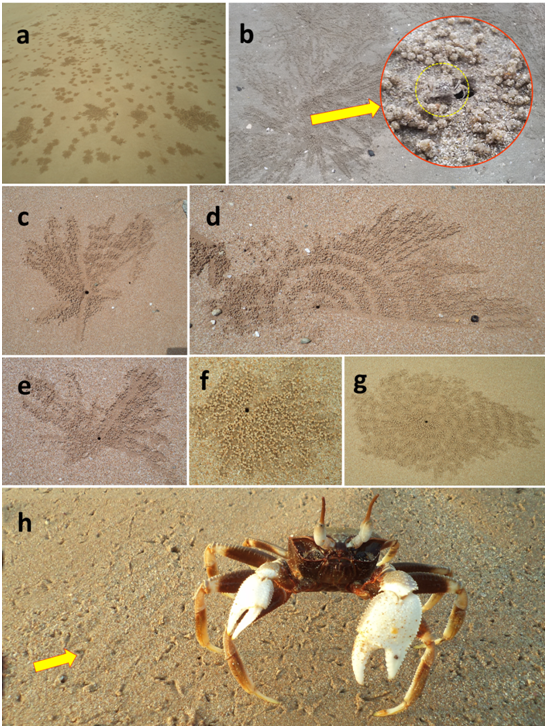
Figure 1 (A-G) Sand bubbler crab Scopimera sp. making different artistic designs around its burrow with small sand pellets; (H) A horned ghost crab, Ocypode ceratophthalma leaves irregular foot signs on shore.
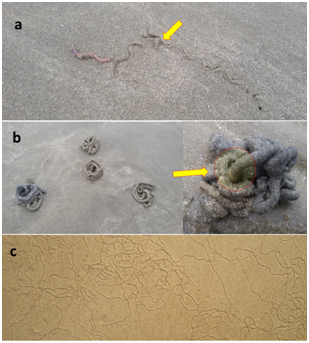
Figure 2 (a) An unidentified marine nematode worm tracks; (b) Defaecated sediment of lug worm Arenicola marina; (c) Unidentified marine worm tracks.
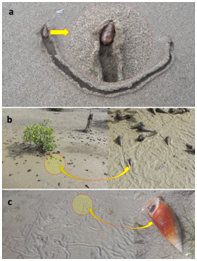
Figure 3 (a)Olive snail, Oliva reticulata f. azona (asa new record to Andaman from this study) creeping in the sandy beach, Lohabarack; (b) Girdled horn shell,Cerithidea cingulata tracks in mangrove environment; (c)Tracks of knobbled horn shell Rhinoclavis sinensis.
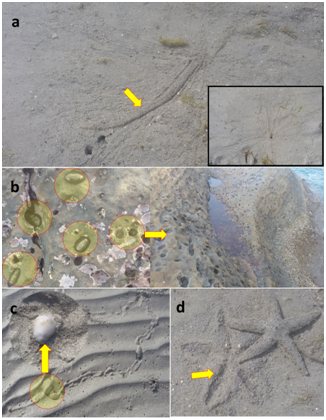
Figure 4 (a) An unidentified worm signs around its burrowduring foraging; (b) These holes on rock are due to large number of chitons; (c) Foot track of albino moon shell Polynices mamilla; (d) Body impression of starfish Archaster typicus.
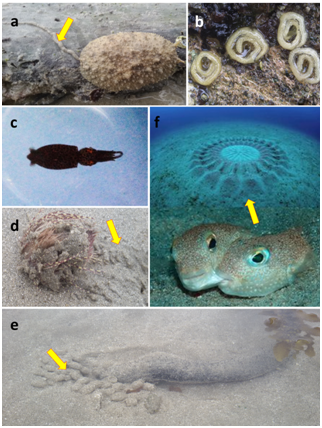
Figure 5(a)An elongated excrement being excreted by a sea slug on arotten wood on the shore; (b) Egg cases of a sea slug; (c)Juvenile and adult squids expel dark black ink into sea to evade predators; (d)Tube feetand spines tracks of heart urchin Lovenia elongata; (e)Fecal pellets of sea cucumber Holothuria atra; (f)Sand circles made by male pufferfish Torquigener albomaculosus (Photo credit: Yoji Okata).
Footprints on sea shores have an important role in taxanomical identification of animals, evolutionary and forensic perspectives. Therefore, in-depth investigations are still needs to be done on this aspect to develop the atlas of footprint maps of marine animals for future perspective.
The authors declare no conflict of interests.
Ramesh is greatful to the INSPIRE fellowshi funded by the Department of Science and Technology under file no. DST/IF120230.

©2018 Ramesh, et al. This is an open access article distributed under the terms of the, which permits unrestricted use, distribution, and build upon your work non-commercially.